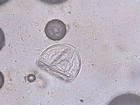Anoplocephala
| This article is still under construction. |
Introduction
Several species of Anoplocephala occur in equidae, but A. perfoliata is the only common species in the UK. It is an equine cestode, more commonly known as a tapeworm. It is currently commonly seen in horses within the UK, usually affecting younger horses.
Recognition
- Superficially, A. perfoliata looks more like a trematode than a tapeworm, but closer inspection reveals that the body compromises many segments that are wide, but very short.
- It typically grows to approximately 5cm, but can be longer.
- The gravid segment contains characteristic eggs with a ‘rounded triangular’ shape.
- The oncosphere is contained in the ‘pyriform apparatus’ (a chitinous ring with two projections).
- The eggs do not float well in the flotation fluids used in routine faecal examination and may be overlooked. Special techniques are required for this purpose, but none are reliable. An ELISA has therefore been developed to demonstrate specific antibodies in blood.
Life-Cycle
Each worm has male and female segments, which reproduce via hemaphroditism. The male segment fertilises the female segment. The reproductive organs then deteriorate, leaving only a uterus full of eggs. This then detachesfrom the rest of the worm and migrates to the large intestine, where it ruptures releasing the eggs.
The eggs released are infective to oribatid mites, which act as the intermediate host. These mites live in the ground, feeding on plant debris. These are ubiquitous, but most numerous on permanent pasture in the summer months.
The mites ingest the egg. Cysticercoid larvae hatch, and live within the mite for its entire life. These cysticercoid become infective around two weeks after hatching.
The horse, which acts as the definitive , ingests the mites in spring, when grazing the pasture.
They attach to the mucosa and into adults in around 6- 10 weeks. The adults live in the ileum, at the ileocaecocolic valve, and within the caecum. The adults are capable of shedding large numbers of eggs.
The prepatent period is 6-10 weeks.
A. perfoliata is found mainly in the caecum, clustered around the ileo-caecal junction, where it causes superficial ulceration and mild inflammation. Generally, it is of little clinical significance, but epidemiological evidence suggests that heavy infections (greater than 20 tapeworms) are a significant risk factor in some forms of colic.
